Feathery False Lily Of The Valley
(Maianthemum racemosum subsp. amplexicaule)
Feathery False Lily Of The Valley (Maianthemum racemosum subsp. amplexicaule)
/
/

Andrey Zharkikh
CC BY 2.0
Image By:
Andrey Zharkikh
Recorded By:
Copyright:
CC BY 2.0
Copyright Notice:
Photo by: Andrey Zharkikh | License Type: CC BY 2.0 | License URL: https://creativecommons.org/licenses/by/2.0/ | Uploader: AndreyZharkikh | Publisher: Flickr
























Estimated Native Range
Climate Requirements for Jerusalem, Israel
| This Plant | Your Site | Plant Suitability for Your Location | ||
|---|---|---|---|---|
| • Precipitation | 7" - 122" | 17" | Your precipitation may be insufficient for this plant. Irrigate N" / year. | Irrigate N" / year |
| • High Temp. | 53°F - 100°F | 83°F | Your summer temperatures are normal for this plant. | Excellent |
| • Low Temp. | -5°F - 44°F | 40°F | Your winter temperatures are normal for this plant | Excellent |
This plant should grow well at your location with about N inches per year (Y minutes per month) of irrigation.
Summary
Maianthemum racemosum subsp. amplexicaule, commonly known as Feathery False Lily of the Valley, Treacleberry, or False Solomon’s Seal, is a perennial herb native to rich, moist, deciduous forests, and forest edges in North America. It exhibits a moderate growth rate, reaching heights of 1.5-2.5 feet (0.46-0.8 meters). This plant features arching stems with alternate, oval to oblong leaves that clasp the stem. The small, creamy-white flowers are arranged in feathery, terminal panicles and bloom in late spring to early summer, followed by speckled red berries in the fall. The flowers are modestly showy, attracting pollinators such as bees and butterflies.
Feathery False Lily of the Valley is valued for its graceful foliage and understated floral display, which adds texture and interest to shaded garden areas. It is commonly used in woodland gardens, as a ground cover, or in naturalized areas. It thrives in part shade to full shade and prefers medium moisture, well-drained loam soils. While generally low-maintenance, it can spread to form colonies and should be given space to naturalize. Gardeners should be aware of its potential to spread, though it is not typically aggressive.CC BY-SA 4.0
Feathery False Lily of the Valley is valued for its graceful foliage and understated floral display, which adds texture and interest to shaded garden areas. It is commonly used in woodland gardens, as a ground cover, or in naturalized areas. It thrives in part shade to full shade and prefers medium moisture, well-drained loam soils. While generally low-maintenance, it can spread to form colonies and should be given space to naturalize. Gardeners should be aware of its potential to spread, though it is not typically aggressive.CC BY-SA 4.0
Plant Description
- Plant Type: Herb
- Height: 1.5-2.5 feet
- Width: 2-3 feet
- Growth Rate: Moderate
- Flower Color: White
- Flowering Season: Spring
- Leaf Retention: Deciduous
Growth Requirements
- Sun: Part Shade, Full Shade
- Water: Medium
- Drainage: Medium
Common Uses
Bird Garden, Border Plant, Groundcover, Low Maintenance, Water Garden
Natural Habitat
Rich, moist, deciduous forests, and forest edges in North America
Other Names
Common Names: Treacleberry, Feathery False Lily Of The Vally, Western Solomon’s Seal, False Solomon’s Seal
Scientific Names: Maianthemum racemosum subsp. amplexicaule, Maianthemum amplexicaule, Maianthemum racemosum var. amplexicaule, Smilacina amplexicaulis, Smilacina amplexicaulis var. glabra, Smilacina amplexicaulis var. jenkinsii, Smilacina amplexicaulis var. ovata, Smilacina racemosa subsp. amplexicaulis, Smilacina racemosa var. amplexicaulis
GBIF Accepted Name: Maianthemum racemosum subsp. amplexicaule